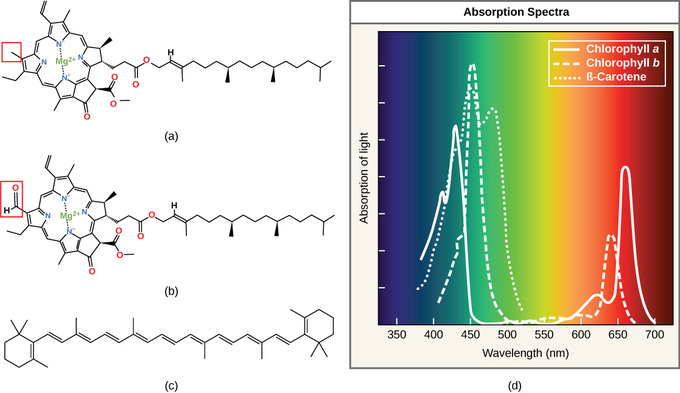What Pigment Molecule Absorbs Blue and Red Light to Provide Energy for Photosynthesis
viii.2B: Absorption of Light
- Page ID
- 13207
Pigments, like chlorophyll and carotenoids, blot and reflect light at a sure region of the electromagnetic spectrum.
Learning Objectives
- Differentiate between chlorophyll and carotenoids.
Key Points
- Found pigment molecules absorb only calorie-free in the wavelength range of 700 nm to 400 nm; this range is referred to as photosynthetically-agile radiation.
- Violet and blue have the shortest wavelengths and the most energy, whereas ruby-red has the longest wavelengths and carries the least amount of energy.
- Pigments reverberate or transmit the wavelengths they cannot absorb, making them appear in the corresponding color.
- Chorophylls and carotenoids are the major pigments in plants; while in that location are dozens of carotenoids, there are simply five important chorophylls: a, b, c, d, and bacteriochlorophyll.
- Chlorophyll a absorbs light in the blueish-violet region, chlorophyll b absorbs red-blue low-cal, and both a and b reflect green light (which is why chlorophyll appears green).
- Carotenoids absorb light in the blue-dark-green and violet region and reflect the longer yellow, ruddy, and orange wavelengths; these pigments also dispose backlog energy out of the prison cell.
Key Terms
- chlorophyll: Any of a group of green pigments that are establish in the chloroplasts of plants and in other photosynthetic organisms such as cyanobacteria.
- carotenoid: Any of a course of yellow to red plant pigments including the carotenes and xanthophylls.
- spectrophotometer: An instrument used to measure the intensity of electromagnetic radiation at different wavelengths.
Absorption of Calorie-free
Low-cal free energy initiates the procedure of photosynthesis when pigments absorb the calorie-free. Organic pigments have a narrow range of free energy levels that they can absorb. Energy levels lower than those represented by red low-cal are insufficient to raise an orbital electron to an excited, or breakthrough, state. Energy levels higher than those in blue low-cal will physically tear the molecules apart, a process called bleaching. For example, retinal pigments can merely "run into" (blot) 700 nm to 400 nm light; this is visible light. For the same reasons, plant pigment molecules absorb just light in the wavelength range of 700 nm to 400 nm; institute physiologists refer to this range for plants every bit photosynthetically-active radiation.
The visible calorie-free seen by humans equally the color white low-cal actually exists in a rainbow of colors in the electromagnetic spectrum, with violet and blue having shorter wavelengths and, thus, higher energy. At the other cease of the spectrum, toward red, the wavelengths are longer and have lower energy.

Understanding Pigments
Different kinds of pigments exist, each of which has evolved to blot merely certain wavelengths or colors of visible calorie-free. Pigments reflect or transmit the wavelengths they cannot absorb, making them appear in the respective color.
Chlorophylls and carotenoids are the 2 major classes of photosynthetic pigments constitute in plants and algae; each grade has multiple types of pigment molecules. There are v major chlorophylls: a, b, c and d, along with a related molecule found in prokaryotes called bacteriochlorophyll.
With dozens of unlike forms, carotenoids are a much larger group of pigments. The carotenoids found in fruit, such as the cherry of tomato (lycopene), the yellow of corn seeds (zeaxanthin), or the orange of an orangish peel (β-carotene), are used to attract seed-dispersing organisms. In photosynthesis, carotenoids function as photosynthetic pigments that are very efficient molecules for the disposal of backlog free energy. When a leafage is exposed to full sun, the calorie-free-dependent reactions are required to process an enormous corporeality of energy; if that free energy is not handled properly, it tin can do significant damage. Therefore, many carotenoids are stored in the thylakoid membrane to blot excess free energy and safely release that free energy equally heat.
Each blazon of paint tin exist identified by the specific pattern of wavelengths information technology absorbs from visible light, which is the assimilation spectrum. Chlorophyll a absorbs light in the blue-violet region, while chlorophyll b absorbs red-bluish light. Neither a or b absorb green light; because dark-green is reflected or transmitted, chlorophyll appears green. Carotenoids absorb light in the blue-dark-green and violet region and reflect the longer yellowish, red, and orangish wavelengths.

Many photosynthetic organisms accept a mixture of pigments. In this way organisms tin can absorb energy from a wider range of wavelengths. Not all photosynthetic organisms have full admission to sunlight. Some organisms grow underwater where light intensity and quality decrease and change with depth. Other organisms grow in competition for light. Plants on the rainforest flooring must be able to blot any light that comes through because the taller trees absorb most of the sunlight and scatter the remaining solar radiation

When studying a photosynthetic organism, scientists can determine the types of pigments present by using a spectrophotometer. These instruments can differentiate which wavelengths of light a substance can absorb. Spectrophotometers measure transmitted light and compute its assimilation. By extracting pigments from leaves and placing these samples into a spectrophotometer, scientists can identify which wavelengths of light an organism tin absorb.
Source: https://bio.libretexts.org/Bookshelves/Introductory_and_General_Biology/Book%3A_General_Biology_(Boundless)/08%3A_Photosynthesis/8.2%3A_The_Light-Dependent_Reactions_of_Photosynthesis/8.2B%3A_Absorption_of_Light
0 Response to "What Pigment Molecule Absorbs Blue and Red Light to Provide Energy for Photosynthesis"
Post a Comment